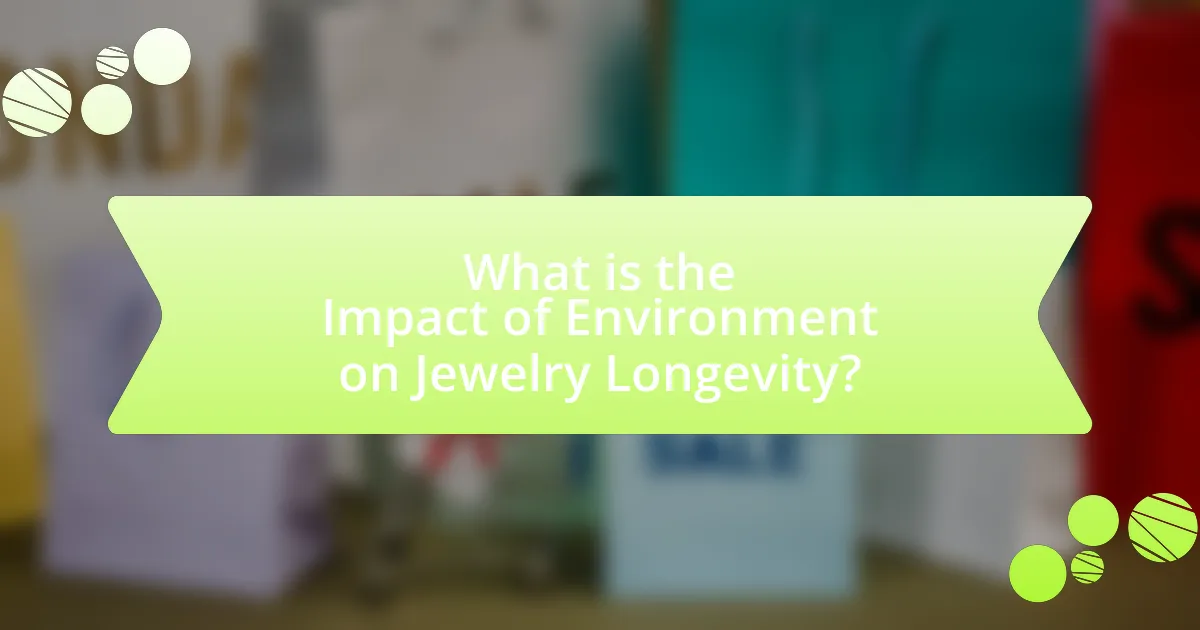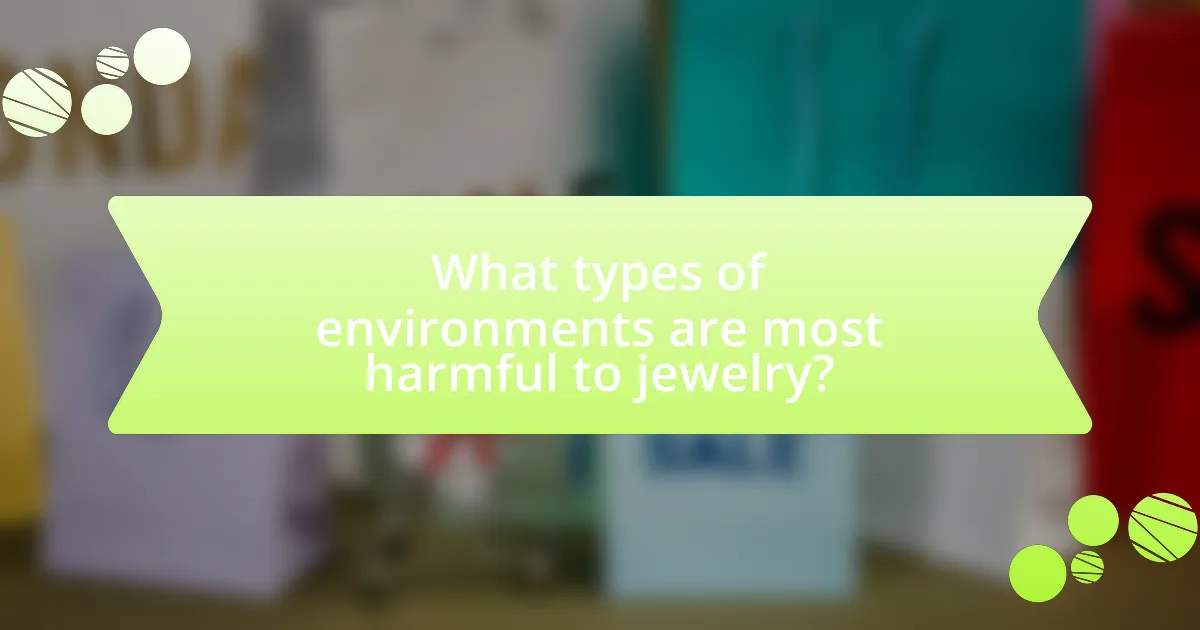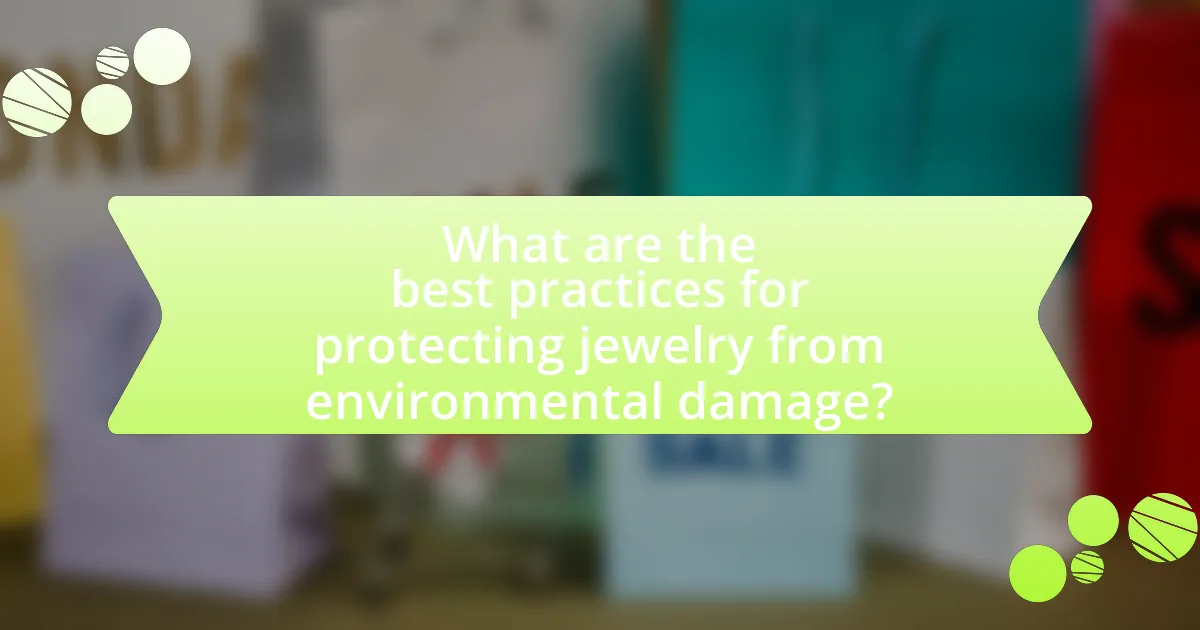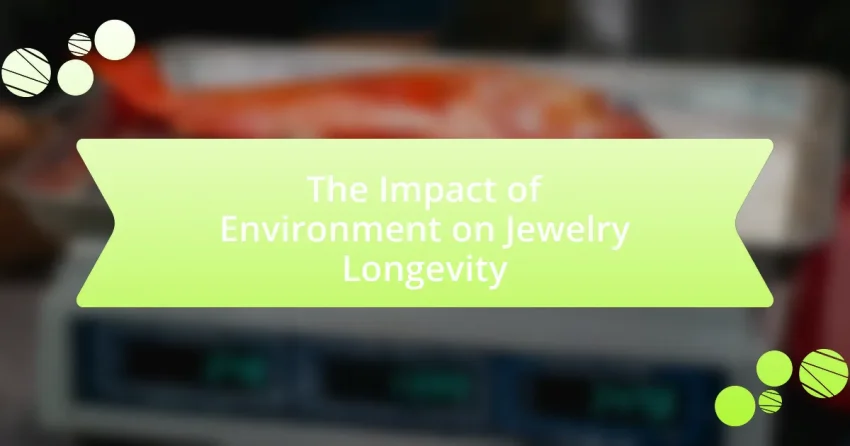The article examines the impact of environmental factors on the longevity of jewelry, highlighting how elements such as humidity, temperature, and exposure to chemicals can lead to deterioration, discoloration, and structural damage. It details the specific effects of these factors on various types of jewelry, including metals and gemstones, and emphasizes the importance of understanding these influences for effective jewelry care. Additionally, the article outlines best practices for protecting jewelry from environmental damage, including proper storage, regular cleaning, and preventative measures during wear, ultimately aiming to enhance the lifespan and appearance of jewelry.

What is the Impact of Environment on Jewelry Longevity?
The environment significantly impacts jewelry longevity by influencing factors such as humidity, temperature, and exposure to chemicals. High humidity can lead to tarnishing of metals and degradation of materials like pearls and leather, while extreme temperatures can cause structural damage to gemstones and settings. Additionally, exposure to chemicals found in household cleaners, perfumes, and even sweat can accelerate corrosion and discoloration. For instance, silver jewelry can tarnish quickly when exposed to sulfur compounds in the air, demonstrating how environmental conditions directly affect the lifespan and appearance of jewelry.
How does environmental exposure affect different types of jewelry?
Environmental exposure significantly affects different types of jewelry by causing deterioration, discoloration, and structural damage. For instance, exposure to moisture can lead to tarnishing in silver jewelry, while high humidity can promote corrosion in metals like copper. Additionally, ultraviolet light can fade gemstones and damage organic materials such as pearls and coral. Research indicates that prolonged exposure to pollutants can accelerate the degradation of jewelry materials, with studies showing that air quality directly correlates with the longevity of metal and gemstone integrity. Therefore, the specific environmental conditions, including humidity, temperature, and exposure to chemicals, play a crucial role in determining the lifespan and appearance of various jewelry types.
What specific environmental factors contribute to jewelry deterioration?
Specific environmental factors that contribute to jewelry deterioration include humidity, temperature fluctuations, exposure to chemicals, and light. High humidity can lead to tarnishing of metals, while extreme temperature changes can cause materials to expand and contract, leading to structural damage. Chemicals found in household cleaners, perfumes, and even skin oils can corrode or discolor jewelry. Additionally, prolonged exposure to sunlight can fade gemstones and weaken certain materials. These factors collectively compromise the integrity and appearance of jewelry over time.
How do temperature and humidity levels influence jewelry materials?
Temperature and humidity levels significantly influence jewelry materials by affecting their structural integrity and appearance. High temperatures can cause metals to expand, potentially leading to warping or changes in shape, while extreme humidity can promote corrosion in certain metals, such as silver, which tarnishes when exposed to moisture. Additionally, gemstones may experience changes in clarity or color due to temperature fluctuations, as some stones are sensitive to heat. For instance, opals can crack if subjected to rapid temperature changes, and pearls can absorb moisture, leading to deterioration if humidity levels are too high. These effects underscore the importance of maintaining stable environmental conditions to preserve the longevity and aesthetic quality of jewelry.
Why is understanding the environment important for jewelry care?
Understanding the environment is crucial for jewelry care because environmental factors such as humidity, temperature, and exposure to chemicals can significantly affect the integrity and appearance of jewelry. For instance, high humidity can lead to tarnishing of metals, while extreme temperatures can cause gemstones to crack or become discolored. Additionally, exposure to household chemicals, such as cleaning agents, can damage both the metal and stones in jewelry. Studies have shown that proper environmental conditions can extend the lifespan of jewelry, making awareness of these factors essential for maintaining its beauty and value.
What are the consequences of neglecting environmental factors in jewelry maintenance?
Neglecting environmental factors in jewelry maintenance can lead to significant deterioration of the jewelry’s condition. For instance, exposure to humidity can cause tarnishing in metals like silver, while extreme temperatures can weaken gemstones and lead to cracking. Additionally, neglecting to store jewelry in a controlled environment can result in scratches and abrasions from contact with other pieces. Studies have shown that proper maintenance, including regular cleaning and appropriate storage, can extend the lifespan of jewelry by preventing these damaging effects.
How can environmental awareness enhance jewelry longevity?
Environmental awareness can enhance jewelry longevity by promoting sustainable practices in sourcing materials and manufacturing processes. When jewelers prioritize eco-friendly methods, they reduce the environmental impact associated with mining and production, which often leads to higher quality and more durable products. For instance, using recycled metals and ethically sourced gemstones minimizes the depletion of natural resources and ensures that the materials are less likely to degrade over time. Additionally, sustainable practices often involve better craftsmanship, which contributes to the overall durability of the jewelry. Studies have shown that jewelry made from responsibly sourced materials tends to have a longer lifespan due to the quality of the materials and the care taken in their production.

What types of environments are most harmful to jewelry?
Environments with high humidity, extreme temperatures, and exposure to chemicals are most harmful to jewelry. High humidity can lead to tarnishing and corrosion, particularly in metals like silver and copper. Extreme temperatures can cause materials to expand or contract, potentially leading to damage or breakage. Additionally, exposure to chemicals found in household cleaners, perfumes, and swimming pools can degrade gemstones and metals, compromising the integrity and appearance of the jewelry.
How do natural environments impact jewelry durability?
Natural environments significantly impact jewelry durability through factors such as humidity, temperature fluctuations, and exposure to elements like saltwater and UV radiation. For instance, high humidity can lead to tarnishing in metals like silver, while extreme temperatures can cause materials like gemstones to crack or become discolored. Additionally, exposure to saltwater can corrode certain metals, reducing their lifespan. Research indicates that jewelry worn in coastal areas often shows signs of wear more quickly due to these environmental factors, highlighting the importance of considering the surrounding environment when assessing jewelry longevity.
What effects do saltwater and chlorine have on jewelry?
Saltwater and chlorine can cause significant damage to jewelry. Saltwater can lead to corrosion, particularly in metals like silver and gold, while chlorine can weaken and discolor materials, especially in gold and gemstones. For instance, chlorine can cause gold to become brittle and can damage the integrity of gemstones, leading to cracks or loss of luster. Studies have shown that prolonged exposure to these elements can result in irreversible damage, emphasizing the importance of removing jewelry before swimming in chlorinated pools or saltwater environments.
How does exposure to sunlight affect gemstones and metals?
Exposure to sunlight can cause fading, discoloration, and structural damage to gemstones and metals. For instance, certain gemstones like amethyst and topaz can lose their color intensity when exposed to prolonged sunlight, as ultraviolet rays break down their chemical structure. Similarly, metals such as silver can tarnish more quickly when exposed to sunlight, as heat and light can accelerate the oxidation process. Studies have shown that gemstones like citrine and aquamarine can also experience changes in hue due to light exposure, indicating that environmental factors significantly impact their longevity and appearance.
What urban factors can lead to jewelry degradation?
Urban factors that can lead to jewelry degradation include pollution, humidity, and temperature fluctuations. Pollution, particularly from industrial emissions and vehicle exhaust, can cause tarnishing and corrosion of metals and gemstones. High humidity levels can promote the growth of mold and mildew, which can damage organic materials like pearls and leather. Additionally, temperature fluctuations can lead to thermal expansion and contraction, potentially causing structural weaknesses in jewelry settings. These environmental conditions are well-documented in studies on material science, highlighting their detrimental effects on the longevity of jewelry.
How do pollutants and chemicals in the air affect jewelry materials?
Pollutants and chemicals in the air can significantly degrade jewelry materials, particularly metals and gemstones. For instance, exposure to sulfur compounds can lead to tarnishing of silver, while chlorine and other chemicals can cause corrosion in gold and platinum. Additionally, airborne particulate matter can scratch and dull the surface of gemstones, diminishing their luster. Studies have shown that urban environments with high levels of air pollution can accelerate these effects, leading to a noticeable decline in the appearance and integrity of jewelry over time.
What role does indoor environment play in jewelry preservation?
The indoor environment plays a crucial role in jewelry preservation by influencing factors such as humidity, temperature, and exposure to light. High humidity can lead to tarnishing of metals and degradation of materials, while low humidity can cause drying and cracking of gemstones and organic materials. Optimal temperature ranges, typically between 20-25 degrees Celsius, help maintain the integrity of jewelry, preventing warping or damage. Additionally, exposure to direct sunlight can fade gemstones and damage certain materials over time. Maintaining a stable indoor environment with controlled humidity and temperature is essential for prolonging the lifespan and appearance of jewelry.

What are the best practices for protecting jewelry from environmental damage?
To protect jewelry from environmental damage, it is essential to store it properly, clean it regularly, and avoid exposure to harmful substances. Proper storage involves keeping jewelry in a dry, cool place, preferably in a soft-lined box or pouch to prevent scratches and tarnishing. Regular cleaning with a soft cloth helps remove dirt and oils that can cause deterioration. Additionally, avoiding exposure to chemicals found in household cleaners, perfumes, and lotions is crucial, as these substances can damage the metal and stones. Research indicates that prolonged exposure to moisture and humidity can lead to corrosion, particularly in metals like silver and copper, emphasizing the importance of these protective measures.
How can jewelry be stored to minimize environmental impact?
Jewelry can be stored to minimize environmental impact by using sustainable materials and methods. Utilizing eco-friendly storage options, such as organic cotton pouches or recycled cardboard boxes, reduces reliance on plastic and harmful chemicals. Additionally, storing jewelry in a controlled environment, away from direct sunlight and humidity, helps prevent tarnishing and damage, thereby extending the lifespan of the pieces. This approach not only conserves resources by reducing the need for replacements but also aligns with sustainable practices that prioritize environmental health.
What types of storage solutions are most effective for different jewelry types?
Effective storage solutions for different jewelry types include individual compartments for delicate items like earrings and rings, anti-tarnish pouches for silver jewelry, and humidity-controlled boxes for pearls. Individual compartments prevent tangling and scratching, which is crucial for delicate pieces. Anti-tarnish pouches contain chemicals that absorb moisture and prevent tarnishing, extending the life of silver jewelry. Humidity-controlled boxes maintain optimal moisture levels, protecting pearls from damage caused by excessive dryness or humidity. These storage methods are validated by industry practices that emphasize the importance of environmental control in preserving jewelry integrity.
How does regular cleaning contribute to jewelry longevity?
Regular cleaning significantly contributes to jewelry longevity by removing dirt, oils, and tarnish that can cause deterioration over time. These contaminants can lead to scratches, discoloration, and weakening of the metal or gemstones. For instance, a study published in the Journal of Gemmology indicates that regular maintenance can extend the life of jewelry by preventing buildup that accelerates wear and tear. By ensuring that jewelry is cleaned regularly, its aesthetic appeal and structural integrity are preserved, ultimately enhancing its lifespan.
What preventative measures can be taken during wear?
Preventative measures that can be taken during wear include removing jewelry before engaging in activities that may cause damage, such as exercising, swimming, or using harsh chemicals. These actions help to minimize exposure to elements that can lead to tarnishing, scratching, or structural damage. For instance, chlorine in swimming pools can corrode certain metals, while sweat can lead to tarnishing over time. Additionally, storing jewelry properly when not in use, such as in a soft pouch or a separate compartment, can prevent scratches and tangling.
How can one avoid exposing jewelry to harmful substances?
To avoid exposing jewelry to harmful substances, individuals should store their jewelry in a dry, cool place away from chemicals and moisture. This practice minimizes contact with substances like perfumes, lotions, and cleaning agents that can cause tarnishing or damage. Additionally, using anti-tarnish pouches or cloths can provide an extra layer of protection against oxidation and corrosion. Studies indicate that exposure to household chemicals can significantly reduce the lifespan of jewelry, emphasizing the importance of proper storage and handling.
What are the best practices for wearing jewelry in various environments?
The best practices for wearing jewelry in various environments include selecting appropriate materials, considering the activity level, and maintaining proper care. For instance, in humid environments, opting for stainless steel or silicone jewelry can prevent tarnishing and corrosion, while in active settings, wearing durable pieces like rubber or metal can reduce the risk of damage. Additionally, removing jewelry before engaging in activities such as swimming, exercising, or cleaning helps preserve its condition. Regular cleaning and proper storage also contribute to longevity, as dirt and chemicals can degrade materials over time.
What practical tips can enhance jewelry longevity in different environments?
To enhance jewelry longevity in different environments, it is essential to store jewelry properly, avoid exposure to harsh chemicals, and clean it regularly. Proper storage involves keeping jewelry in a dry, cool place, ideally in a soft-lined box or pouch to prevent scratches and tangling. Avoiding exposure to harsh chemicals, such as those found in cleaning products or swimming pools, helps prevent tarnishing and damage to the metal and stones. Regular cleaning with a soft cloth and appropriate cleaning solutions maintains the jewelry’s shine and integrity. These practices are supported by the fact that jewelry can degrade due to environmental factors, with studies indicating that exposure to moisture and chemicals significantly accelerates wear and tear.
